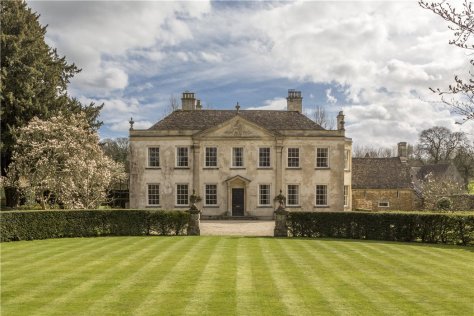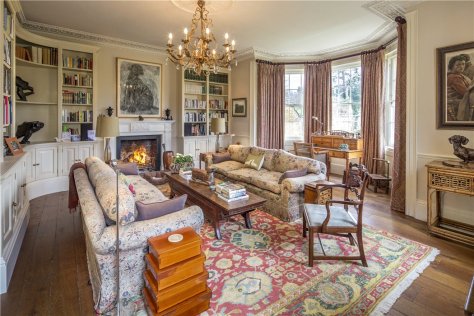“It is the kind of house that takes a lot of living up to,” Evelyn Waugh wrote in his diary, as if rehearsing his favourite role as country squire

The selling point for Piers Court, on the market at Knight Frank with a £3 million guide price, is its connection with Evelyn Waugh, the author of Brideshead Revisited, who lived here between 1937 and 1956.
Notwithstanding, Piers Court at Stinchcombe, near Dursley, has a history going back much farther. The Grade II* listed house stands on the site of a medieval manor of that name burned down by Parliamentary troops searching for Prince Rupert on his march from Cirencester to Berkeley Castle (about six miles away) in 1645. Piers Court, a safe house for Royalists, was owned by the wealthy land and mill owning Pynffold family who remained for 150 years.
According to Historic England, the remains of the earlier building were incorporated into an 18th century property which is the house we see today.

Evelyn Waugh was born in Hampstead in 1903, the second son of Arthur Waugh, who was a contributor to The Yellow Book, an essayist and a publisher. He was educated at Lancing and Hertford College, Oxford, and, like many other writers, he taught in a private school for a time. His first novel, Decline and Fall, was published in 1928 and he followed it with nine years of travel which included the Arctic, tropical America and Abyssinia. He became a Roman Catholic in 1939 and had a varied war service, including membership of the British Military Mission to Yugoslavia in 1944. He married Laura, a daughter of Colonel Aubrey Herbert, an MP for Yeovil, in 1937 and settled at Piers Court, where he collected books. His novels included Decline and Fall (1928), Vile Bodies (1930), Black Mischief (1932), A Handful of Dust (1934), Scoop (1938), Put Out More Flags (1942), Brideshead Revisited (1945), The Loved One (1948), Helena (1950) and Men at Arms (1952).

Evelyn Waugh bought Piers Court for £3,600 in 1937, having been given the money by his future parents-in-law, in readiness for his marriage to Laura Herbert, his second wife. (His first marriage to Evelyn Gardner had been annulled in 1926).
The outbreak of war meant their stay at Piers Court was cut short. The Waugh’s let the house to a convent school for £600 a year in October 1939, Laura moved to Pixton Park in Somerset, and Evelyn served with the Army in Crete and Yugoslavia. It wasn’t until September 1945 that they returned.
There are contradictory stories about Evelyn Waugh’s feelings towards Piers Court. He was initially said to have ‘fallen in love’ with the house; his son, Auberon Waugh, later recalled in his book Will This Do? how he and his siblings knew “the front of the house belonged strictly to my father . . . one detected his presence as soon as we walked into the pretty hall, with its white and black stone floor and glass chandelier”. The enforced absence might have been responsible for his later abating attitude regarding Piers Court.

Frances Donaldson, in Evelyn Waugh – Portrait of a Country Neighbour, wrote in 1968:
“I always loved the drawing-room at Piers Court. The rest of the house was a question of taste – Evelyn’s taste. Personally, I became very fond of that too, but I could understand why other people disliked it. Evelyn liked dark surfaces and pattern, heavy furniture, silver and glass. There was much that was Victorian in the house, but his taste was masculine and, although the house was enlivened with personal eccentricities, it was genuinely of the period.
“In his library the carved shelves were built out in bays as they are in a public library and painted dark green, but it was a big room and the effect was rather beautiful while this arrangement provided room for his collection of books. The dining-room was sombre but the hall, staircase and landing above were light and elegant. The whole house right down to the Abyssinian paintings in the gentlemen’s lavatory was uniquely different from any other house I have ever been in.
“The drawing-room into which we were shown on that first night spoke as much of Laura as of Evelyn. They both loved and had considered knowledge of fine furniture and they bought eighteenth-century pieces when they could afford to. On the walls hung pictures from Evelyn’s collection of Victorian painters including the Augustus Egg of two girls in a boat, and I remember with vivid affection the faded green velvet curtains banded with chintz which hung in the circular bay window and the cushions which they had bought in a country house sale. On this night a fire burned in the grate and the chintz-covered chairs and sofa were reassuring.”

According to Knight Frank, much can be learnt about Evelyn Waugh and his time spent at Piers Court from his diary entries and the letters he wrote to his friends, many of whom were noted intellectuals in the twentieth century.
Ironically, it was also Knight, Frank and Rutley who handled the sale of Piers Court when the Waughs tired of the house. The official line was that Evelyn had, in June 1955, received an unsolicited visit from Nancy Spain, a reporter from the Daily Express, demanding an interview. He showed her the door, but the damage had been done. Spain wrote up the episode and, within weeks, Waugh put Piers Court on the market. “I felt as if the house had been polluted,” he wrote to the estate agent, furious at the invasion of his privacy. “If you happen to meet a lunatic who wants to live in this ghastly area, please tell him.”


The truth about their departure was probably best summed up by Frances Donaldson:
“Whether or not I am right in my view, the happy days came to an end in 1956. Evelyn began to be restless, ostensibly because he believed the town of Dursley was creeping up to his gates, but really I think because he wished for change, to break the rut of boredom in which he was sunk.”
Various buyers came to light, among them a Colonel and a Sir Anthony Lindsay-Hogg, but it wasn’t until June 1956 that a Mrs Gadsden made an offer of £9,500 for Piers Court, which was accepted. The Waughs moved to a manor house at Combe Florey in Somerset where Evelyn died in 1966.



Piers Court is approached up a long drive, lined with high beech hedges.
According to Knight Frank, the house is extremely well presented and benefits from both an imposing, formal layout ideal for entertaining, yet to the rear of the property lies a homelier arrangement of rooms ideal for family living. Off the main entrance hall are the formal drawing room and library, both of which provide the grandeur that would be expected of a Georgian manor house.
Described by Country Life as a genial, pleasantly rambling family house with some 8,400sq ft of accommodation, including five reception rooms. There is also a kitchen/breakfast room with a beautiful beamed ceiling, tiled floor and lovely rustic feel. Upstairs there are eight bedrooms and six bathrooms … plus extensive attics and a one-bedroom staff wing.
The front garden is lawned with a circular clipped yew hedge encompassing an ornamental fountain. The secret garden is of particular note, with high clipped yew hedges and bordered by a stone wall. Gravel walkways lead to the Gothic edifice which was built by Evelyn Waugh when he was creating the gardens. The croquet lawn and tennis court are well screened by a high beech hedge which creates a corridor of alternating green and copper beech.
Piers Court has an array of deep beds which fill with colour in the spring and summer months. There are many garden components. The Coach House looks over the oval walled garden with ornamental ponds framed by careful planting. The park is arranged as pasture with parkland trees including horse chestnut, lime, oak and copper beech. Lying to the south of the parkland is further grassland divided by a hedgerow. A footpath crosses part of the land to the west of the house.
Of course, there have been a few owners since, and probably most traces of Evelyn Waugh’s existence have long-since disappeared. Back in 2004, the then-custodian revealed that his beloved library was long gone. “Under a previous owner, the library where Waugh wrote was shipped, piece by piece, to Texas, where it was supposed to be reconstructed as a museum but is still in packing cases.”










